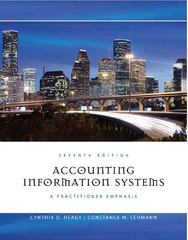Question
I have done my work already it is just that i want you to check for me the work through TURNITON to check for plagiarism
I have done my work already it is just that i want you to check for me the work through TURNITON to check for plagiarism and if there is any please fix it.
Subject: Research and analyze whether transactions are eligible for non-recognition treatment under IRC 351. Using your tax research memo template developed in Module One, prepare a tax research memorandum to problem C: 2-62 in your textbook
The memorandum should point out that the transfers of property to a controlled corporation are nontaxable only if the transferors control the transferee corporation immediately after the exchange (Sec. 351(a)). Section 368(c) defines control in terms of two 80% tests. Regulation Sec. 1.351-1(a) outlines some of the requirements of the control test but does not directly address the question of a prearranged binding agreement whereby one transferor sells one-half of his stock to someone who is not a transferor. Example (1) of Reg. Sec. 1.351-1(b) permits a transfer to qualify under Sec. 351 where transferee corporation stock is transferred by gift from a controlling transferor to his son, who also is a transferor, immediately after the exchange. Regulation Sec. 1.351-1(a)(1)(ii) permits a shareholder to be ignored as a transferor when the amount of stock issued directly for property is of relatively small value in comparison to the value of the stock already owned or to be received by the person who transferred the property.
Under Rev. Rul. 79-194, 1979-1 C.B. 145, the control requirement of Sec. 351(a) is to be determined after any sales or transfers occur. In Situation 1 of this ruling, the control requirement is satisfied when part of the 80% stock interest in a newly created corporation that was acquired by a transferor corporation was sold to a group of investors who had acquired the other 20% stock interest in the original transaction. In this situation, the shift in ownership occurred among individuals who were transferors, and the recipients owned a substantial amount of the corporations stock.
In a second situation, described in Rev. Rul. 79-194, the control requirement was not met upon completion of a sale under a similar agreement, whereby a transferor who originally had acquired 99% of the stock sold one-half the stock of the new corporation to a second transferor who had originally acquired only 1% of the stock. The IRS held that the control requirement was not met because the 1% shareholder received stock of small value in the original transfer relative to the amount received in total and, therefore, was not considered to be a transferor.
In the current case, it must be determined whether Bob has received a substantial part of the Stone Corporation stock or not. Revenue Procedure 77-37, 1977-2 C.B. 568, Sec. 3.07, indicates that ownership of 10% of the stock to be owned is not of small value and therefore should be considered a substantial part of the stock. Under this authority, the control requirement should be met and the transaction should be permitted to qualify under Sec. 351.
Step by Step Solution
There are 3 Steps involved in it
Step: 1

Get Instant Access to Expert-Tailored Solutions
See step-by-step solutions with expert insights and AI powered tools for academic success
Step: 2

Step: 3

Ace Your Homework with AI
Get the answers you need in no time with our AI-driven, step-by-step assistance
Get Started


